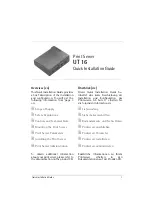
•
Preprinted papers that require a registration (the precise print location on the page) greater than ±2.3 mm
(±0.9 in.), such as optical character recognition (OCR) forms
In some cases, registration can be adjusted with a software application to successfully print on these forms.
•
Coated papers (erasable bond), synthetic papers, thermal papers
•
Rough
‑
edged, rough or heavily textured surface papers, or curled papers
•
Recycled papers that fail EN12281:2002 (European)
•
Paper weighing less than 60 g/m
2
(16 lb)
•
Multiple
‑
part forms or documents
Selecting preprinted forms and letterhead
•
Use grain long paper.
•
Use only forms and letterhead printed using an offset lithographic or engraved printing process.
•
Avoid paper with rough or heavily textured surfaces.
•
Use inks that are not affected by the resin in toner. Inks that are oxidation
‑
set or oil
‑
based generally meet
these requirements; latex inks might not.
•
Print samples on preprinted forms and letterheads considered for use before buying large quantities. This
action determines whether the ink in the preprinted form or letterhead affects print quality.
•
When in doubt, contact your paper supplier.
•
When printing on letterhead, load the paper in the proper orientation for your printer. For more information,
see the
Paper and Specialty Media Guide
.
Storing paper
Use these paper storage guidelines to help avoid jams and uneven print quality:
•
Store paper in its original wrapper in the same environment as the printer for 24 to 48 hours before printing.
•
Extend the time several days if the storage or transportation environment is very different from the printer
environment. Thick paper may also require a longer conditioning period.
•
For best results, store paper where the temperature is 21°C (70°F) and the relative humidity is 40 percent.
•
Most label manufacturers recommend printing in a temperature range of 18–24°C (65–75°F) with relative
humidity between 40 and 60 percent.
•
Store paper in cartons, on a pallet or shelf, rather than on the floor.
•
Store individual packages on a flat surface.
•
Do not store anything on top of individual paper packages.
•
Take paper out of the carton or wrapper only when you are ready to load it in the printer. The carton and
wrapper help keep the paper clean, dry, and flat.
Supported paper sizes
Notes:
•
Paper less than 210 mm (8.3 in.) wide always prints at reduced speed.
•
Use the manual feeder when printing on paper less than 105 mm (4.1 in.) wide.
•
The minimum paper dimension supported for two
‑
sided printing is 210 x 279.4 mm (8.3 x 11 in.).
Learn about the printer
13














































